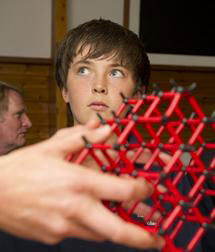| Jun 29, 2011 | |
Schools play with nanotechnology |
|
| (Nanowerk News) Pupils aged 12-14 years old from Kingham-Hill School, Marlborough School, The Oxford Academy, and Oxford High School, took part in the event where they got to learn about the basic science behind applications of nanotechnologies and investigate the properties of nanoscale materials. | |
| After a short introductory talk by Dr Christiane Norenberg, Programme Manager for Nanotechnology at the Begbroke Directorate, the school students took part in ten different activities, these included: | |
 Buckyballs: The pupils made cardboard models of fullerenes – molecules made entirely out of carbon – that in their spherical form are known as 'buckyballs' and resemble the geodesic domes used in the architecture of The Eden Project. Ball and stick models of different forms of carbon introduced buckyballs and carbon nanotubes – materials that are leading the way to new electronic technologies. Dilution: Using test tubes and pipettes, the students prepared a series of dilutions of a solution containing scented food colouring to illustrate the idea of concentrations and colloids (a substance microscopically dispersed evenly throughout another substance). Examples of colloids include; milk, mayonnaise, mist, and blood. Magic sand: An experiment using 'magic sand' - ordinary sand coated with a nanoscale hydrophobic ('water-fearing') coating. The sand forms balls and sinks when put into water but then remains completely dry when removed from water. The experiment introduced students to the properties and applications of hydrophobic coatings. |
| Source: University of Oxford |
